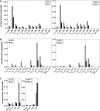Blood sphingolipidomics in healthy humans: impact of sample collection methodology
- PMID: 20660127
- PMCID: PMC2936747
- DOI: 10.1194/jlr.D008532
Blood sphingolipidomics in healthy humans: impact of sample collection methodology
Abstract
We used a HPLC-MS/MS methodology for determination of a basic metabolomic profile (18:1,18:0 sphingoid backbone, C(14)-C(26) N-acyl part) of "normal" sphingolipid levels in human serum and plasma. Blood was collected from healthy males and nonpregnant females under fasting and nonfasting conditions with and without anticoagulants. Sphingolipids analyzed included sphingoid bases, sphingosine and dihydrosphingosine, their 1-phosphates (S1P and dhS1P), molecular species (C(n)-) of ceramide (Cer), sphingomyelin (SM), hexosylceramide (HexCer), lactosylceramide (LacCer), and Cer 1-phosphate (Cer1P). SM, LacCer, HexCer, Cer, and Cer1P constituted 87.7, 5.8, 3.4, 2.8, and 0.15% of total sphingolipids, respectively. The abundant circulating SM was C(16)-SM (64.0 µM), and it increased with fasting (100 µM). The abundant LacCer was C(16)-LacCer (10.0 µM) and the abundant HexCer was C(24)-HexCer (2.5 µM). The abundant Cer, C(24)-Cer (4.0 µM), was not influenced by fasting; however, levels of C(16)-C(20) Cers were decreased in response to fasting. S1P levels were higher in serum than plasma (0.68 µM vs. 0.32 µM). We also determined levels of sphingoid bases and SM species in isolated lipoprotein classes. HDL(3) was the major carrier of S1P, dhS1P, and Sph, and LDL was the major carrier of Cer and dhSph. Per particle, VLDL contained the highest levels of SM, Cer, and S1P. HPLC-MS/MS should provide a tool for clinical testing of circulating bioactive sphingolipids in human blood.
Figures








References
-
- Cuvillier O., Pirianov G., Kleuser B., Vanek P. G., Coso O. A., Gutkind S., Spiegel S. 1996. Suppression of ceramide-mediated programmed cell death by sphingosine-1-phosphate. Nature. 381: 800–803. - PubMed
-
- Hannun Y. A. 1996. Functions of ceramide in coordinating cellular responses to stress. Science. 274: 1855–1859. - PubMed
-
- Spiegel S., Merrill A. H., Jr 1996. Sphingolipid metabolism and cell growth regulation. FASEB J. 10: 1388–1397. - PubMed
-
- Vesper H., Schmelz E. M., Nikolova-Karakashian M. N., Dillehay D. L., Lynch D. V., Merrill A. H., Jr 1999. Sphingolipids in food and the emerging importance of sphingolipids to nutrition. J. Nutr. 129: 1239–1250. - PubMed
Publication types
MeSH terms
Substances
Grants and funding
LinkOut - more resources
Full Text Sources
Other Literature Sources
Miscellaneous

